9 Best Carbon Offsets for Events (Complete 2024 List)
Impactful Ninja is reader-supported. When you buy through links on our site, we may earn an affiliate commission.
Learn more
Learn more
.
Hey fellow impactful ninja ? You may have noticed that Impactful Ninja is all about providing helpful information to make a positive impact on the world and society. And that we love to link back to where we found all the information for each of our posts. Most of these links are informational-based for you to check out their primary sources with one click. But some of these links are so-called "affiliate links" to products that we recommend. First and foremost, because we believe that they add value to you. For example, when we wrote a post about the environmental impact of long showers, we came across an EPA recommendation to use WaterSense showerheads. So we linked to where you can find them. Or, for many of our posts, we also link to our favorite books on that topic so that you can get a much more holistic overview than one single blog post could provide. And when there is an affiliate program for these products, we sign up for it. For example, as Amazon Associates, we earn from qualifying purchases. First, and most importantly, we still only recommend products that we believe add value for you. When you buy something through one of our affiliate links, we may earn a small commission - but at no additional costs to you. And when you buy something through a link that is not an affiliate link, we won’t receive any commission but we’ll still be happy to have helped you. When we find products that we believe add value to you and the seller has an affiliate program, we sign up for it. When you buy something through one of our affiliate links, we may earn a small commission (at no extra costs to you). And at this point in time, all money is reinvested in sharing the most helpful content with you. This includes all operating costs for running this site and the content creation itself. You may have noticed by the way Impactful Ninja is operated that money is not the driving factor behind it. It is a passion project of mine and I love to share helpful information with you to make a positive impact on the world and society. However, it's a project in that I invest a lot of time and also quite some money. Eventually, my dream is to one day turn this passion project into my full-time job and provide even more helpful information. But that's still a long time to go. Stay impactful,Affiliate Disclosure
Why do we add these product links?
What do these affiliate links mean for you?
What do these affiliate links mean for us?
What does this mean for me personally?
![]()
Events such as conferences, concerts, and sporting events all have a carbon footprint associated with them, and it is often higher than you might think. Carbon offsetting is one method that can reduce these emissions, but finding organizations that offer event carbon offsets can be difficult. So, we had to ask: What are the best carbon offsets for events?
The best organizations for event carbon offsets in terms of overall impact are myclimate, Cool Effect, Sustainable Travel International, and Native Energy. Carbonfund provides standardized offsets for small or large events, and Feast It is a booking platform that offsets event emissions.
Keep reading to learn more about the best carbon offsets for events, how these carbon offset projects work, what their respective offsetting costs are, and what your best way would be to offset your carbon emissions. At the end of the article, we’ll also share with you what the biggest carbon offsetting limitations are and why reducing your carbon footprint is more effective than offsetting it.
Here’s What All the Best Carbon Offsets for Events Have in Common
Carbon offsets are reductions in carbon emissions that are used to compensate for carbon emissions occurring elsewhere. They are measured in tons of CO2 equivalents and are bought and sold through international brokers, online retailers, and trading platforms on what is known as the global carbon offset market.
“Carbon Offset: a way for a company or person to reduce the level of carbon dioxide for which they are responsible by paying money to a company that works to reduce the total amount produced in the world, for example by planting trees”
Oxford Dictionary
When you purchase carbon offsets, it’s important that they actually make a difference in total carbon emissions. To achieve that, the following are key criteria:
- Carbon offset projects have to be effective (different projects have different effectiveness rates)
- Carbon offset projects have to be additional
- Carbon offset projects have to be permanent
- The claims from carbon offset projects have to be verifiable
(For a full overview, check out our guide on how to choose carbon offset projects that actually make a difference.)
These Are the Best Carbon Offsets for Events in 2024
Below are our favorite carbon offsets for events (you can click on their link to directly jump to their section in this article):
| Carbon Offsets for Events | Quick Facts |
| myclimate | About: Purchasing event carbon offsets funds offset projects involving energy efficiency, forestry, waste management, and renewable energy. Costs: $23-$30 per 1,000kg of CO2 |
| Cool Effect | About: Purchasing event carbon offsets funds offset projects involving avoided nature loss (forestry, tree planting, grasslands), methane capture, and clean cookstoves. Costs: $14.62 per 1,000kg of CO2 |
| Sustainable Travel International | About: Purchasing event carbon offsets funds offset projects involving forestry, clean and efficient energy, blue carbon (carbon sequestration), and community-based projects. Costs: Determined after initial contact |
| Native Energy | About: Partnering with them to offset the emissions of your event funds offset projects such as Improving Agriculture in Uganda. Costs: Determined after initial contact |
| Carbonfund | About: Carbonfund offers offsets for both small and large events. Purchases support offset projects involving energy efficiency, forestry, and renewable energy. Costs: $12.50 per 1,000kg of CO2 |
| Feast It | About: Feast It has an event carbon emissions calculator that can offset the emissions from various events. Purchases support offset projects carried out by Eden Reforestation Projects and overseen by Ecologi. Costs: Approximately $14.40 per 1,000kg of CO2 |
| Co2nsensus | About: Co2nsensus has an event calculator that calculates, analyzes, and offsets your event’s carbon emissions. Purchases support offset projects involving reforestation, wind energy, energy efficiency, landfill gas, biomass, and hydropower. Costs: Pricing varies depending on the details of your event and the offset project you select. |
| Clear | About: Clear offers a variety of event carbon offsets. Purchases support offset projects involving reforestation, efficient cookstoves, renewable energy, methane capture, and landfill gas capture. Costs: $25 per 1,000kg of CO2 |
| Terrapass | About: Purchasing their Green Wedding Carbon Offset funds offset projects involving farm power, landfill gas capture, clean energy from wind power, and abandoned coal mine methane capture. Costs: $15.98, $6.66, or $5.99 per 1,000 kg of CO2 |
myclimate: Shaping the Future
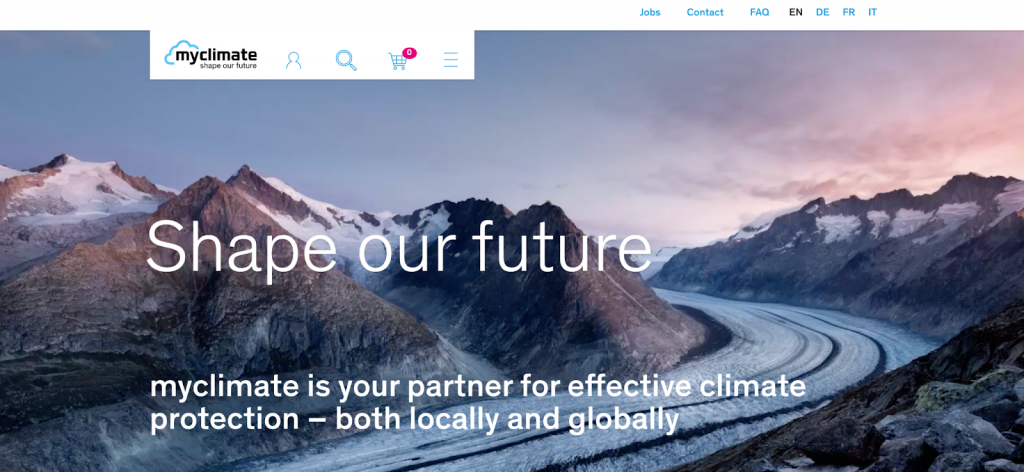
myclimate was founded in 2002 by Renat Heuberger, Thomas Camerata, and Patrick Bürgi as an international climate organization with Swiss roots. Today, they have expanded to 45 countries and work with companies of all sizes, public administrations, non-profit organizations, and private individuals to provide high-quality carbon offset projects with quantifiable climate protection.
“myclimate is your partner for effective climate protection – locally and globally”
myclimate
Project overview: myclimate provides an event carbon offset calculator, where they take into account any general information, mobility, accommodations, catering, energy usage, materials, transport, and waste of an event. After calculating the emissions from your event, you can purchase individual or subscription carbon offsets or make a donation. Purchases fund offset projects including energy efficiency, forestry, waste management, and renewable energy. Some examples include efficient cookstoves in the Himalayas, forest management in Switzerland, and hydropower in Vietnam. myclimate currently has 144 voluntary carbon offset projects in 41 countries.
Carbon offset effectiveness: myclimate offset projects contribute to the UN’s Sustainable Development Goals and are certified according to either the Gold Standard, VCS, or Plan Vivo.
Carbon offset costs: myclimate offers 3 carbon offset options. Individual offsets at $30 per 1,000kg of CO2 offset; monthly subscriptions at $23 per 1,000kg of CO2; and donations at a fixed rate of $30 per 1,000kg of CO2 offset.
How to get your carbon offsets: You can visit their website to offset your emissions from an event, enroll in an offset subscription, or make a donation to myclimate’s mission by either contributing a specific dollar amount or offsetting a certain kg of CO2.
Cool Effect: Giving Like the Planet Depends On It
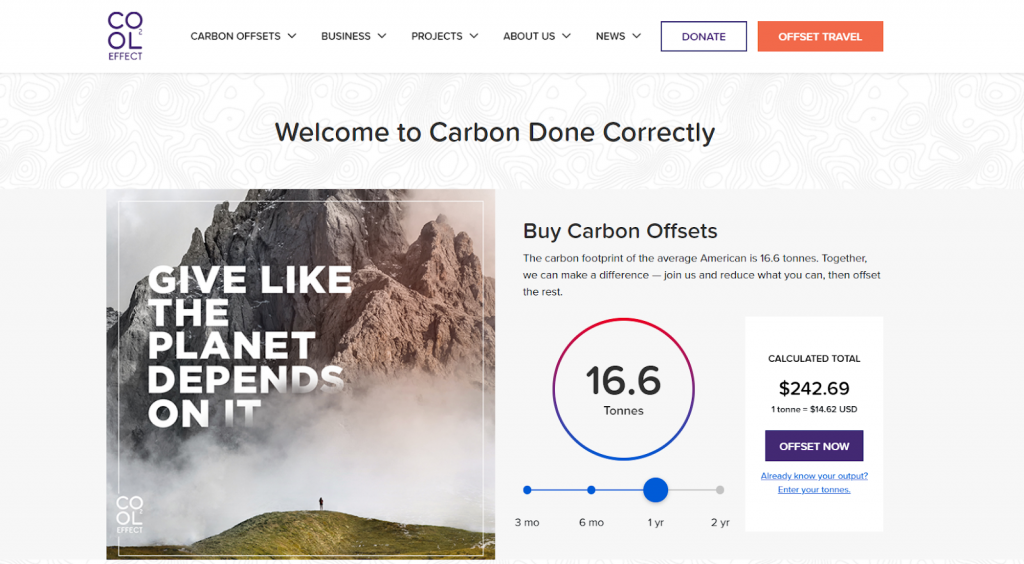
Cool Effect was founded in 1998 by Dee and Richard Lawrence as a small, clean-burning cookstoves project in Honduras. Today, it has grown to represent a platform with 15+ global projects and a community of 500,000+ that offers individuals and businesses the option to offset their carbon footprint.
“Carbon done correctly”
Cool Effect
Carbon offset overview: Through their event calculator, Cool Effect provides businesses the option to offset events of various sizes, including travel for attendees. The calculator takes into account the number of attendees, days, and domestic/international travelers. Purchasing carbon offsets funds carbon offset projects involving avoided nature loss (forestry, tree planting, grasslands), methane capture, and clean cookstoves. These projects are located in the United States (Montana, Oregon, Tennessee), India, China, Myanmar, Indonesia, Honduras, Kenya, and Uganda.
Carbon offset effectiveness: Cool Effect’s projects are 100% additional, rigorously verified, and adhere to the UN’s Sustainable Development Goals.
Carbon offset costs: Their event carbon offsets cost $14.62 per 1,000 kg of CO2.
How to get your carbon offsets: You can visit their website to get your event carbon offsets.
Sustainable Travel International: Transforming Tourism’s Impact on Nature
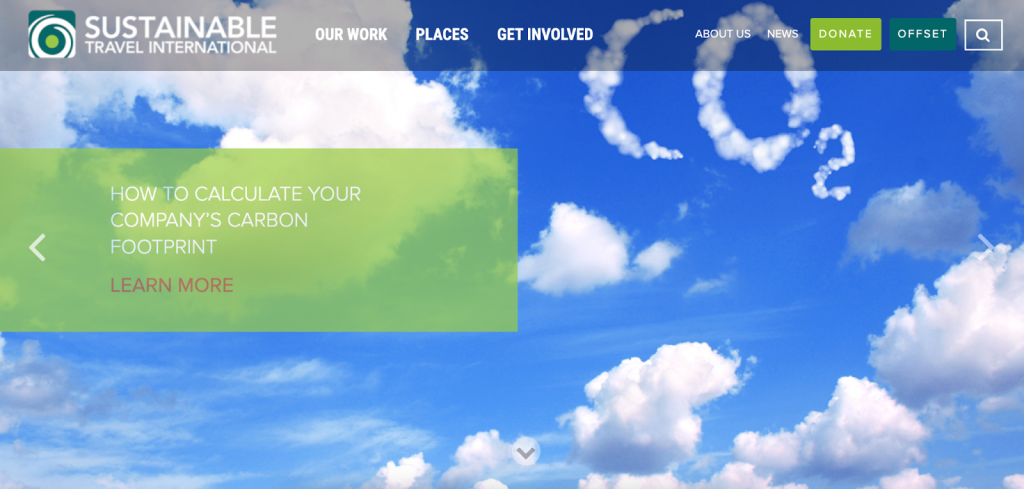
Sustainable Travel International was founded in 2002 by Brian Mullis to transform tourism’s impact on nature and communities by protecting and conserving this planet’s most vulnerable destinations. Today, they have helped individuals and companies offset over 386,309 metric tons (over 386 million kg) of CO2 and have supported various carbon offset projects.
“We’re dedicated to minimizing the negative impacts of tourism and maximizing its positive benefits for people, cultures, nature, and wildlife around the globe”
Sustainable Travel International
Project overview: Sustainable Travel International offers three solutions for businesses looking to offset the carbon footprint of an event: 1) conducting a carbon footprint assessment to calculate the emissions generated by the event, 2) having a portion of event ticket sales go toward carbon offset projects, or 3) adding their carbon calculator on your event website. Purchases fund carbon offset projects involving forestry, clean and efficient energy, blue carbon (carbon sequestration), and community-based projects. Some examples include wind farms in Honduras, reforestation in Brazil, and water filtration in Cambodia.
Carbon offset effectiveness: Sustainable Travel International projects are third-party verified and validated to meet rigorous standards including additionality, permanence, no double-counting, and alignment with the UN’s Sustainable Development Goals.
Carbon offset costs: Costs are determined after initial contact.
How to get your carbon offsets: You can visit their website to get in touch with a representative.
Native Energy: Changing the World Through Climate Projects
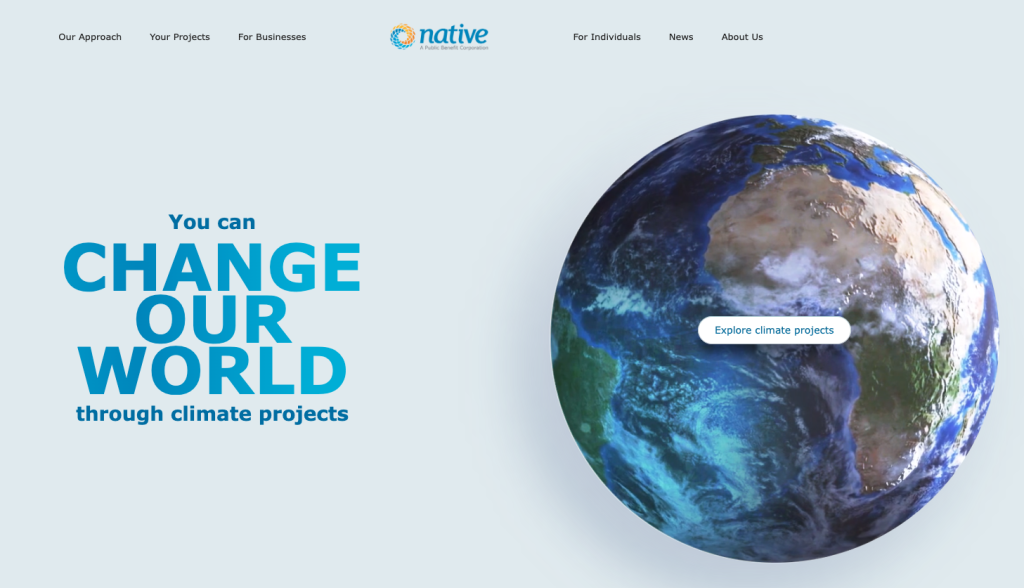
Native Energy was founded in 2000 by Jeff Bernicke as a platform for organizations to implement projects that reduce greenhouse gas emissions and combat climate change.
Today, they offer carbon offsets and renewable energy solutions that provide clients the opportunity to invest and enable the development of new climate projects with direct business benefits.
“Envision your ideal climate solution. Let us build it.”
Native
Project overview: Native offers businesses the option to partner with them to offset the emissions of your event. Native will calculate the carbon footprint of the event, provide carbon offsets and marketing, and share your event with the Native community. With their HelpBuildTM carbon offsets, you purchase offsets from the project in advance. This enables the project to cut greenhouse gas pollution on your behalf for years to come. An example project is the From Waste to Fuel: Improving Agriculture and Livelihoods in Uganda project which provides small farms with digesters that generate biofuel for cooking and organic fertilizer.
Carbon offset effectiveness: Native’s offsets are permanent, additional, third-party verified, and validated to one of the following standards: Verified Carbon Standard, Gold Standard, American Carbon Registry, Climate Action Reserve, Plan Vivo, and the Climate, Community & Biodiversity Alliance to help ensure transparency and quality in the creation, quantification, and verification of offset projects.
Carbon offset costs: Costs are determined after initial contact.
How to get your carbon offsets: You can contact a Native representative for more information and to schedule a consultation.
Carbonfund: Go Carbon Neutral
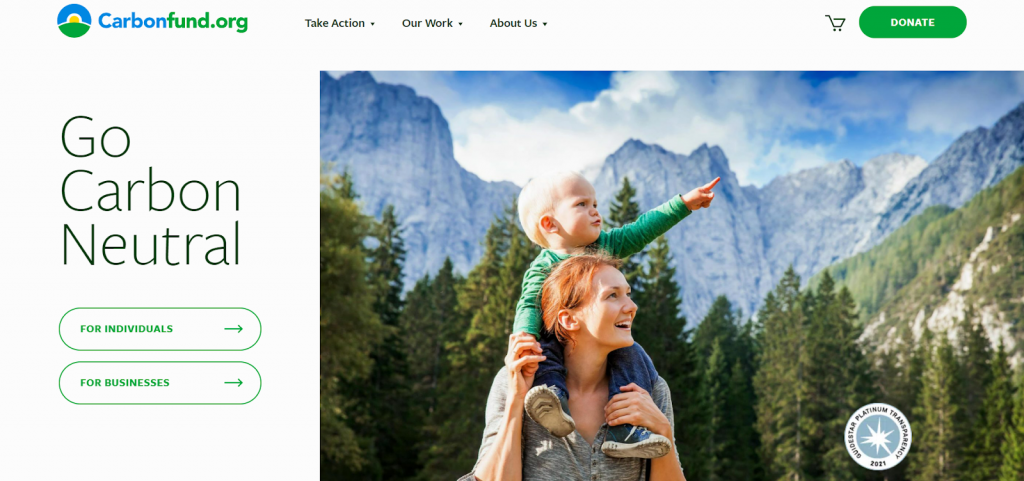
Carbonfund was founded in 2003 by Eric Carlson to make it easy for any individual, business, or organization to reduce and offset their climate impact. Today, they have been incorporated into ClimeCo and provide verified energy efficiency, renewable energy, and forestry carbon offsets for individuals and businesses.
“Reduce what you can, offset what you can’t”
Carbonfund
Project overview: Carbonfund offers offsets for both small (< 250 people) and large (< 500 people) events. The small event package offsets 8 tonnes (16,500 lbs) of CO2, and the large event package offsets 15 tonnes (33,000 lbs) of CO2. Purchases support third-party validated and verified energy efficiency, forestry, and renewable energy carbon offset projects globally. To date, they have supported 240 projects in 28 countries.
Carbon offset effectiveness: Carbonfund projects are third-party verified and adhere to the Verified Carbon Standard, Gold Standard, American Carbon Registry, and Climate Action Reserve to help ensure transparency and quality in the creation, quantification, and verification of offset projects.
Carbon offset costs: Both the small and large event offsets cost $12.50 per 1,000kg.
How to get your carbon offsets: You can visit their event/gift website to view and purchase your small or large event carbon offsets.
Feast It: Partnering With Ecologi to Offset Your Event

Feast It was founded in 2017 by Digby Vollrath and Hugo Campbell as a booking platform to connect customers to food and drink suppliers in the United Kingdom (UK). Today, they are the UK’s leading event booking platform, and they have partnered with Ecologi to plant trees and help you offset the emissions of your event.
“Create your perfect event, simply”
Feast It
Project overview: Feast It has an event carbon emissions calculator that can offset the emissions from a wedding, corporate event, birthday, dinner party, celebration, or public-facing event. Feast It has partnered with Ecologi to provide carbon offset projects carried out by Eden Reforestation Projects. Purchases support reforestation carbon offset projects in the Brazilian Amazon rainforest, Mesoamerican Biological Corridor, and Bosawas Reserve in Nicaragua.
Carbon offset effectiveness: Ecologi’s reforestation and carbon offsetting projects are certified by either the Gold Standard or the Verified Carbon Standard. And Eden Reforestation Projects is included in our list of the Best Charities for Reforestation and Best Carbon Offsets for Reforestation (Planting Trees).
Carbon offset costs: Offsetting your event costs approximately $14.40 per 1,000kg.
How to get your carbon offsets: You can visit their website and use their carbon offset calculator to get your event carbon offsets.
Co2nsensus: A Climate-Tech Company
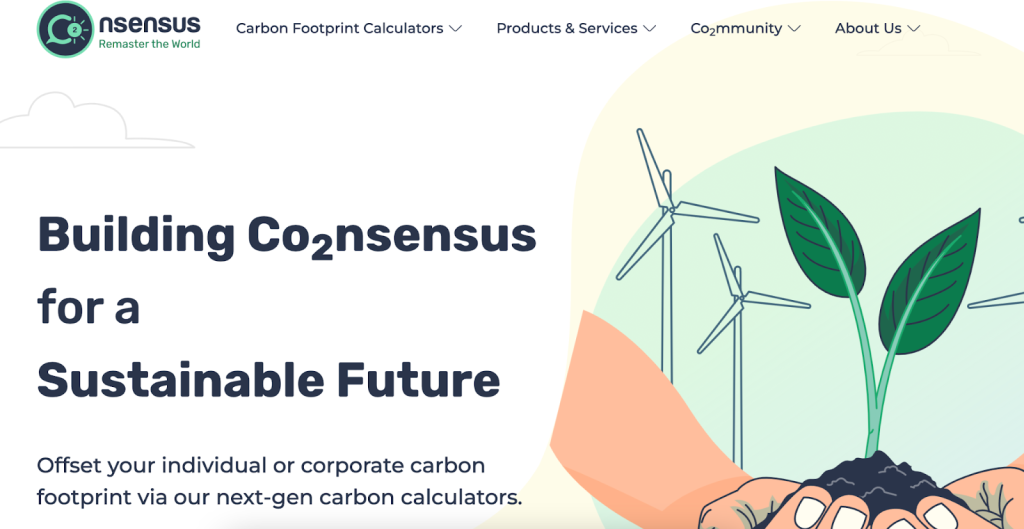
Co2nsensus was founded in 2019 by Bekir Cetin as a climate-tech company focused on helping individuals and businesses neutralize their carbon footprint. Today, they provide various carbon footprint calculators, carbon offsets for individuals, carbon management software, and a carbon-neutral e-delivery system for e-commerce.
“Building Co2nsensus for a Sustainable Future”
Co2nsensus
Project overview: Co2nsensus has an event calculator that calculates, analyzes, and offsets your event’s carbon emissions by taking into account the number and location of participants, number of overnight stays, and number and type of meals. After calculating the footprint, you can then choose a carbon offset project to support. Purchases support carbon offset projects involving reforestation, wind energy, energy efficiency, landfill gas, biomass, and hydropower. Example projects include improved cookstoves in Kenya, hydroelectric power in Turkey, and reforestation in Uruguay.
Carbon offset effectiveness: Co2nsensus’ carbon offset projects are verified by the Gold Standard and Verra and contribute to UN Sustainable Development Goals.
Carbon offset costs: Pricing varies depending on the details of your event and the offset project you select.
How to get your carbon offsets: You can visit their website to use their event calculator and offset emissions from your event.
Clear: Join the Climate Change Mission
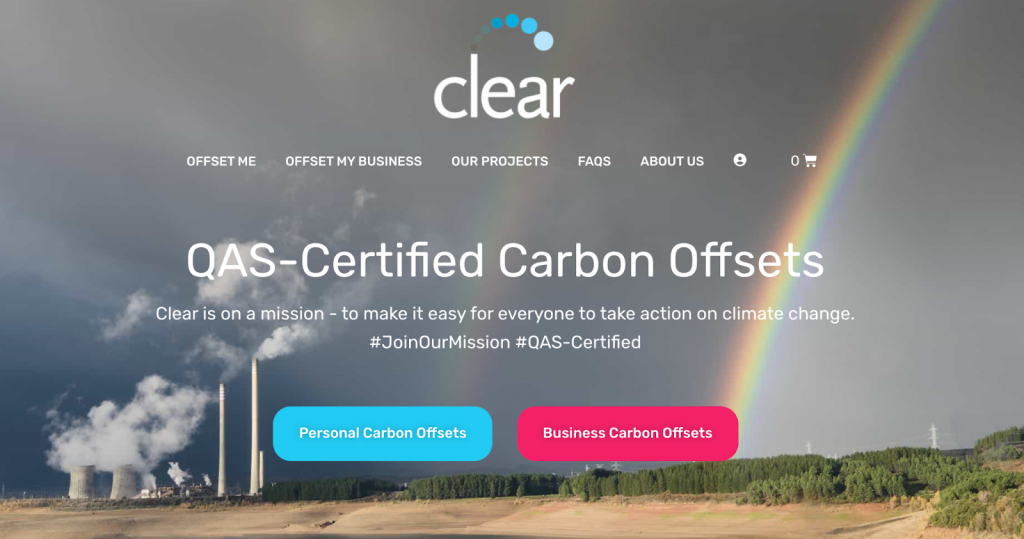
Clear was founded in 2005 to use technology and innovation to empower individuals and smaller companies to easily take environmental action. Today, they provide individuals and businesses the option to offset various activities while supporting verified carbon offset projects around the world.
“Will this carbon offset really cover the emissions I can’t avoid creating?” Clear is dedicated to living up to that promise.”
Clear
Project overview: Clear offers a variety of event carbon offsets, including skydiving, balloon flights, hotel stays, and offices/factories. Or you can download their free QAS-Certified Business Carbon Footprint Audit Tool and take the process offline until you’re ready. They offer the option to make your purchase carbon-neutral, 50% carbon negative, 100% carbon negative, or 200% carbon-negative. Purchases support carbon offset projects involving reforestation, efficient cookstoves, renewable energy, methane capture, and landfill gas capture.
Carbon offset effectiveness: Clear carbon offsets are the first in the world to be independently certified against the Quality Assurance Standard (QAS), a comprehensive independent audit system for companies wanting to become carbon neutral through carbon reduction.
Carbon offset costs: The cost to offset emissions from an event is approximately $25 per 1,000kg of CO2. They also offer the option to make your purchase carbon-negative at 50%, 100%, or 200% which increases the overall cost accordingly.
How to get your carbon offsets: You can use the Clear carbon offset calculator to calculate and offset your emissions from various events. Or you can download their audit tool if you aren’t ready to dive in just yet.
Terrapass: Carbon Offsets for Individuals and Businesses
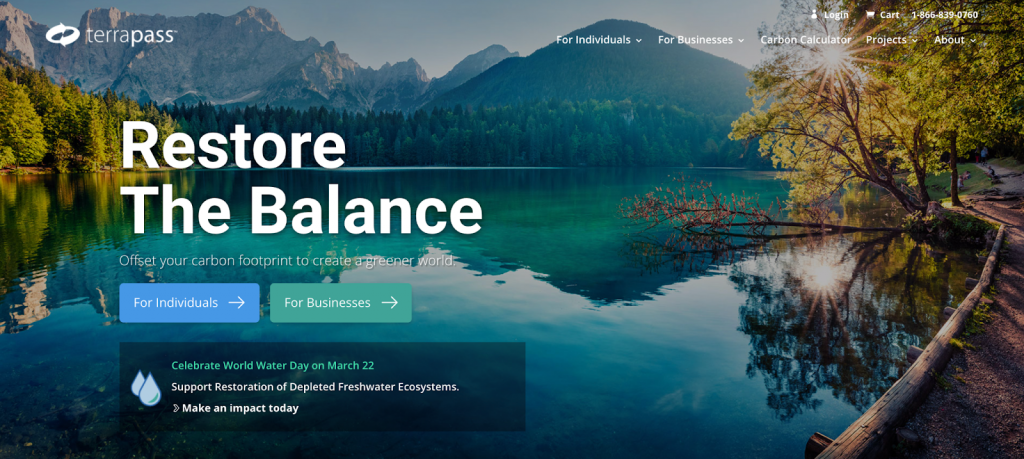
Terrapass was founded in 2004 by Dr. Karl Ulrich to reduce as many carbon emissions as possible via the use of education, online tools, carbon offsets, and renewable energy. Today, they provide verified landfill gas capture, renewable energy, and forestry carbon offsets for individuals and businesses.
“Restore the balance.”
Terrapass
Project overview: Terrapass offers a Green Wedding Carbon Offset that takes into account the number of wedding guests. Depending on the specific plan, it offsets air travel, accommodations, ground transportation, venue, meals, and a honeymoon. Purchases help fund carbon offset projects including farm power, landfill gas capture, wind power, and abandoned coal mine methane capture.
Carbon offset effectiveness: Terrapass uses the Verified Carbon Standard, Gold Standard, American Carbon Registry, and the Climate Action Reserve to help ensure transparency and quality in the creation, quantification, and verification of offset projects.
Carbon offset costs: The Green Wedding Carbon Offset plan comes in 3 packages that offset either 500, 1,500, or 2,500 kg of CO2 at a cost of $15.98, $6.66, or $5.99 per 1,000 kg of CO2, respectively.
How to get your carbon offsets: You can visit their website to view and purchase your Green Wedding Carbon Offset.
How to Choose Carbon Offset Projects Actually Make a Difference
The following information is a summary for you based on our full guide: “How to Buy Carbon Offsets That Actually Make a Difference”
Purchase carbon offset projects with high effectiveness rates. The offset programs in order of most to least effective are:
- Direct CO2 removal: Machines remove CO2 directly from the air. Effective at reducing emissions in the short and long-term because they are additional and permanent.
- Renewable energy: Investing in projects that build and maintain renewable energy sites globally. There is no additionality because renewables are becoming a greater share of our energy mix, with or without the help of offsets.
- Energy efficiency improvements: The creation of products or systems that use less energy than conventional systems to perform the same task. However, if products are replaced too quickly, the amount of CO2 required to produce the new product would exceed the amount of CO2 saved with the new product.
- Carbon sequestration: The long-term storage of carbon via forestry practices. Not an effective way to reduce emissions in the long term because there is no guaranteed permanence.
If – and only if – they are both additional and permanent, carbon offsets can help reduce your overall GHG emissions to balance off your personal carbon footprint to fight climate change – at least in the short term. But they can be much more effective if they meet certain key criteria and project standards.
Here are key criteria to look for in a carbon offset program:
- A clearly defined protocol that determines which types of projects are eligible and how emission reductions will be measured
- Independent third-party verification of compliance with the protocol
- Registration of offsets in an offset registry, which tracks each credit with a unique serial number to ensure it is only used once
- Transparency in project implementation and reporting
If used correctly, carbon offsets can provide environmental, economic, and social benefits that go beyond reducing carbon emissions. They have the potential to instigate meaningful environmental change and begin to reverse some of the effects of climate change.
Carbon offset project standards assure transparency and quality in the creation, quantification, and verification of offset projects. This way you can ensure that the project is actually reducing CO2 emissions. The following are recognized carbon offset standards:
- Verified Carbon Standard (VCS): Considered the world’s leading voluntary GHG program, with 1700+ projects having removed 630+ million tons of CO2 from the atmosphere. Examples of projects include hydropower in Turkey, forest conservation in Peru, and landfill gas capture in China.
- Gold Standard: A certification that seeks to maximize every dollar of climate and development funding. It has issued 134 million carbon credits from 1700+ projects based in more than 80 different countries. Examples of projects include solar power in India, efficient cooking and heating in China, and wind power in Indonesia.
- Climate Action Reserve (CAR): The premier carbon offset registry for the North American carbon market having issued over 150 million offset credits since its inception in 2001. Examples of projects include landfill gas capture in South Carolina and forest management in California.
- American Carbon Registry (ACR): The first private voluntary GHG registry in the world. Examples of projects include ozone-depleting substances in Arkansas and methane capture from mines in Kentucky.
Choosing carbon offset projects from any of the above project standard registries helps ensure that your project is verified and that it actually reduces CO2 emissions.
What Are the Biggest Carbon Offsetting Limitations
In fact, there are 9 main carbon offsetting limitations that can make the current voluntary carbon market controversial and lead to confusion, inconsistencies, and a general distrust of the system. Have a look at the quick summary table below.
| Carbon Offsetting Limitation | Quick Facts |
| #1: You don’t reduce your own carbon footprint | When you purchase a carbon offset, you are paying someone else to cut their emissions so you don’t have to cut your own emissions. |
| #2: Carbon offsets do not work at the core issue of reducing CO2 emissions | Global warming is still occurring at an accelerated rate because offsetting CO2 emissions does not cut CO2 emissions at the source, it only mitigates emissions. |
| #3: Carbon offsetting only reduces CO2 if the projects are additional and permanent | If carbon offset projects are not additional and permanent, they can make climate change worse because they are not offsetting any carbon. |
| #4: “Poorer” countries are paid to offset carbon while the “rich” countries continue to emit | The richest of the world emit the majority of the world’s carbon. Offsets are just licenses to pollute with the benefit of aiding those in developing countries. |
| #5: Different projects have different effectiveness rates | The varying levels of effectiveness of carbon offset programs make it difficult to choose one that actually reduces emissions. The most effective offset programs are renewable energy programs, followed by energy efficiency improvements, carbon sequestration, and aviation offset programs. |
| #6: CO2 offsets are only realized at the end of project durations | If a carbon offset program is not carried out until the end, then we cannot reap the program’s benefits. For example, planting trees is a common offset program that is only effective if those planted trees are protected during their life span for the carbon benefits to be realized. |
| #7: There are not enough offsets for all CO2 emissions | We emit far more CO2 than we can offset because of carbon sink (e.g., atmosphere, forests, soil, ocean) limitations. |
| #8: Not all offset projects get realized | Of the credits for 1 billion tons of CO2 listed on registries, only about 300-400 million tons of CO2 offsets actually get realized. |
| #9: Carbon offsetting projects are often used as greenwashing | Investing in non-verified credits, not prioritizing in-house emissions reductions, and double-counting carbon credits are methods of greenwashing. Also, companies may advertise a specific program, but it may be just for public attention instead of actually reducing emissions. |
Why Reducing Your Carbon Footprint Is More Effective Than Offsetting It
The main argument against carbon offsets is that they don’t really reduce overall emissions. Instead of substituting offsetting carbon emissions, we should instead cut the emissions directly at the source. Basically, if we stop emissions from getting into the atmosphere in the first place, we won’t have to worry about offsetting. But have we done this? Have we cut emissions directly at the source? The data says no.
The COVID-19 pandemic triggered the largest decrease in energy-related carbon emissions since World War II, a decrease of 2 billion tons. However, emissions rebounded quickly at the end of 2020, with levels in December ending 60 million tons higher than those in December 2019. This indicates that the earth is still warming at an accelerated rate, and not enough is being done to implement clean energy practices.
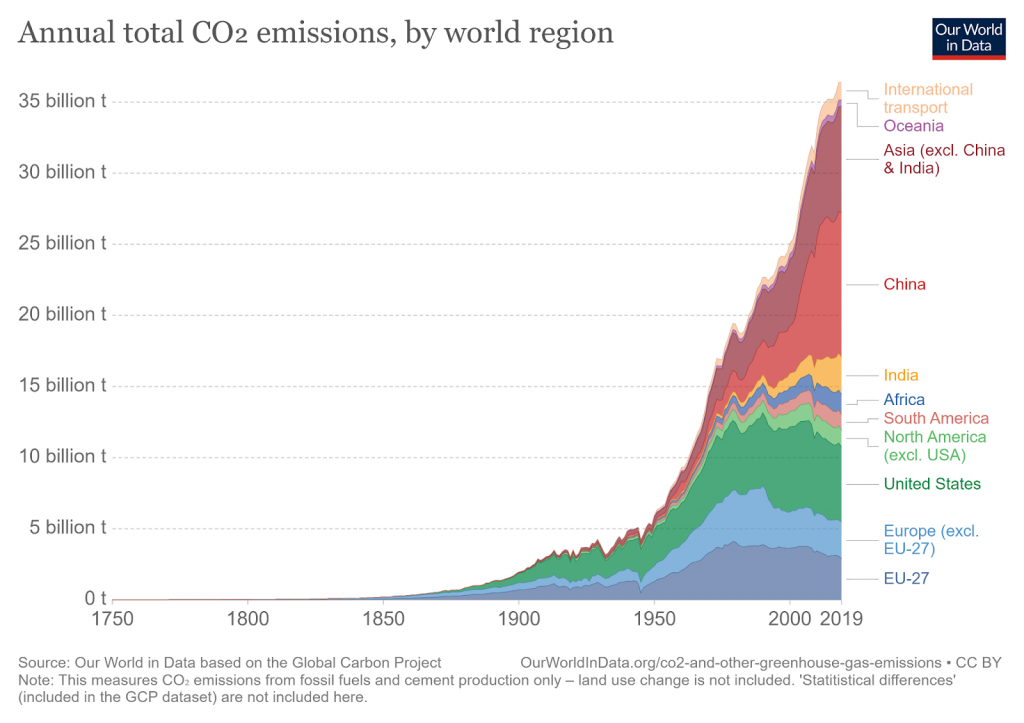
When you buy a carbon offset, you are paying someone else to cut their emissions so you don’t have to cut your own emissions. This is why offsetting alone will not be enough to reduce global carbon emissions.
Carbon offsets are a good place to start if you want to get into the carbon-emission reduction game, but in order to be effective in the long term, we must not rely on them solely. Cutting emissions from the source and then offsetting the remainder is the best way to reduce our carbon footprint and provide the highest environmental benefits. If we fail to cut emissions first, we will fill up our carbon sinks and render them unusable. Preventing carbon emissions rather than reacting once they are already emitted is the best way to reduce overall emissions.
Carbon offsets reduce GHG emissions from fossil fuels (e.g.; coal, oil, and natural gas). Reducing your consumption of these, in turn, reduces your carbon footprint, which has huge impacts on environmental, economic, and public health. A reduced carbon footprint due to lower GHG emissions can mitigate the effects of climate change, improve public health, boost the economy, and maintain plant and animal diversity.
- Climate change: Reducing your carbon footprint plays a role in mitigating the side effects of global climate change. The more we reduce the amount of GHG emissions, the more we slow the rate of temperature rise, sea-level rise, ice melting, and ocean acidification.
- Public health: Reducing GHG emissions lessens the likelihood and severity of extreme weather events, improves air and water quality, maintains biodiversity, and supports a healthy food supply.
- Economics: Reducing GHG boosts the economy, especially when it becomes economically rewarding to innovate solutions that help protect our planet, fight climate change, and are based on clean energy.
- Plant and animal diversity: Protecting biodiversity protects human health because many plants and animals are used in modern medicines
Carbon offsets have the potential to instigate meaningful environmental change, but to make the greatest impact we must understand both their benefits AND drawbacks.
Final Thoughts
myclimate, Cool Effect, Sustainable Travel International, Native Energy, Carbonfund, Feast It, Co2nsensus, Clear, and Terrapass have the best carbon offset options to offset emissions from events. They are third-party verified, permanent, additional, use the leading carbon offset standards, and adhere to the UN’s Sustainable Development Goals.
In short, carbon offsets can help reduce your overall carbon emissions to balance off your personal carbon footprint to fight climate change – at least in the short term. But in the long term, direct methods of carbon footprint reduction are much more effective. Reducing your household carbon footprint first before relying on carbon offsets can make more of a difference in the fight against climate change.
Stay impactful,

Sources
- Our World in Data: CO2 Emissions
- U.S. Environmental Protection Agency: Offsets and RECs -What’s the Difference?
- Britannica: Carbon Offset
- David Suzuki Foundation: Are carbon offsets the answer to climate-altering flights?
- Impactful Ninja: How to Buy Carbon Offsets That Actually Make a Difference
- myclimate: Homepage
- myclimate: About myclimate
- myclimate: Calculate the CO2 footprint of the event
- myclimate: Climate Protection Projects
- United Nations Department of Economic and Social Affairs: The 17 Goals
- The Gold Standard: Homepage
- Verra: Verified Carbon Standard
- Plan Vivo: Homepage
- myclimate: Calculate flight emissions
- myclimate: Climate Protection Subscription
- myclimate: Donation for climate protection
- Cool Effect: Homepage
- Cool Effect: Our History
- Cool Effect: Event Offset
- Cool Effect: Scientifically Verified Carbon Projects and Pricing
- Cool Effect: Our Approach
- Sustainable Travel International: Homepage
- Sustainable Travel International: About Us
- Sustainable Travel International: Carbon Offsets
- Sustainable Travel International: Carbon Offsets for Events
- Sustainable Travel International: Carbon Project Quality Assurance
- Sustainable Travel International: Contact Us – Business Climate Action
- Native Energy: Homepage
- Native Energy: Mission & Values
- Native Energy: Events and Sponsorships
- Native: Carbon offsets – what are they and how do they work
- Native: From Waste to Fuel – Improving Agriculture and Livelihoods in Uganda
- American Carbon Registry: Homepage
- Climate Action Reserve: Homepage
- The Climate, Community & Biodiversity Alliance: Homepage
- Gmail: [email protected]
- Carbonfund: Homepage
- Climeco: Homepage
- Carbonfund: About Us
- Carbonfund: Events/Gifts Carbon Offsets
- Carbonfund: Energy Efficiency
- Carbonfund: Forestry
- Carbonfund: Renewable Energy
- Carbonfund: Carbonfund.org Foundation Project Maps
- Feast It: Homepage
- Ecologi: Homepage
- Feast It: Carbon Offset
- Eden Reforestation Projects: Homepage
- Feast It: Carbon offset your event with feast it
- Impactful Ninja: 9 Best Charities for Reforestation
- Impactful Ninja: 9 Best Carbon Offsets for Reforestation (Planting Trees)
- Co2nsensus: Homepage
- Co2nsensus: Carbon offset projects
- Co2nsensus: Improved Cookstoves Offset Project
- Co2nsensus: Buyukduz Hydroelectric Powerplant – Turkey
- Co2nsensus: Weyerhaeuser’s Forest Plantation, Uruguay
- Co2nsensus: Carbon offset events
- Clear: Homepage
- Clear: About Us
- Clear: Offset my flight
- Clear: Business Carbon Footprint 2021
- Clear: Carbon offset projects at Clear
- Quality Assurance Standard: Homepage
- Terrapass: Homepage
- Terrapass: About Terrapass
- Terrapass: Green Wedding Carbon Offsets
- Natural Resources Defense Council: Carbon Offsets 101
- Terrapass: Project Standards
- Verra: Tepekisla Dam & Hydropower Plant Project
- Verra: The Jaguar Amazon Redd+ Project
- Verra: Sanya Landfill Gas Power Generation Project
- Gold Standard: Gold Standard Impact
- Climate Action Reserve: About Us
- Climate Action Reserve: Registry
- Climate Action Reserve: Bluesource – Berkeley County Landfill Gas Project
- Climate Action Reserve: Buckeye Forest Project
- American Carbon Registry: Our Mission
- American Carbon Registry: Registry
- American Carbon Registry: EOS Climate ODS destruction
- American Carbon Registry: Baker Mine AMM
- Impactful Ninja: What Are the Biggest Carbon Offsetting Limitations? (All 9 Explained)
- GreenPeace: The biggest problem with carbon offsetting is that it doesn’t really work
- International Energy Agency: After steep drop in early 2020, global carbon dioxide emissions have rebounded strongly
- Our World in Data: Annual total CO2 emissions
- Impactful Ninja: What Is the Carbon Footprint of Coal Energy? A Life-Cycle Assessment
- Impactful Ninja: What Is the Carbon Footprint of Oil Energy? A Life-Cycle Assessment
- Impactful Ninja: What Is the Carbon Footprint of Natural Gas? A Life-Cycle Assessment
- Impactful Ninja: 4 Main Reasons Why Reducing Your Carbon Footprint Is Important
- National Wildlife Federation: Climate Change
- National Institute of Environmental Health Sciences: Health Impacts of Climate
- Carbon Tax Center: What’s a Carbon Tax?
- World Health Organization: Biodiversity and Health
- Impactful Ninja: Can You Really Offset Your Carbon Footprint? Here Are the Facts




